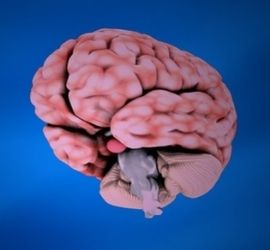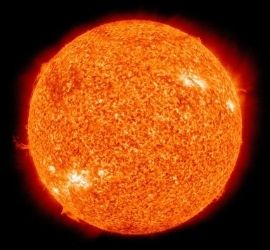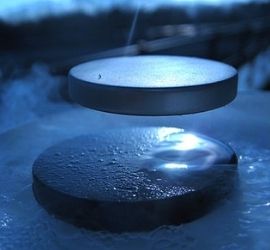Cerebral Cortex Overview
 The cerebral cortex is the outermost layer of the brain made up of tightly packed neurons. Because it is the outer layer, it is the most visible. It is gray in appearance with a wrinkled texture. It is only a few millimeters thick, yet it accounts for almost half the weight of the brain. The brain is one of the largest and most complex organs in the human body. It is composed of billions of neurons. Between 14 billion and 16 billion neurons are found in the cerebral cortex. Cortical neurons function like mini microprocessors or logic gates on a computer chip. These neurons communicate together by forming numerous connections called synapses.
The cerebral cortex is the outermost layer of the brain made up of tightly packed neurons. Because it is the outer layer, it is the most visible. It is gray in appearance with a wrinkled texture. It is only a few millimeters thick, yet it accounts for almost half the weight of the brain. The brain is one of the largest and most complex organs in the human body. It is composed of billions of neurons. Between 14 billion and 16 billion neurons are found in the cerebral cortex. Cortical neurons function like mini microprocessors or logic gates on a computer chip. These neurons communicate together by forming numerous connections called synapses.
The cortex is made up of four lobes – the frontal, temporal, parietal, and occipital. These lobes are named after cranial bones that these lobes overlay. Each lobe processes a different type of sensory information. In total, the cerebral cortex is responsible for higher thought processes. These include speech, decision making, perception, and memory. It is also the center for advanced motor function, social abilities, language, and problem-solving. The brain weight is different between men and women. A man’s brain weighs about 1330-1340 grams. A female’s brain comes in at about 1200 grams. However, just as men typically weigh more than women, so do their organs. The difference in weight shows no real effect regarding function or intelligence.
Cerebral Cortex Function
The cerebral cortex and cerebrum let humans take in sensations from their external environment. They then function to process and decipher meaning so that humans can respond to them in a conscious way.
The cerebral cortex contains sensory areas and motor areas. Sensory areas receive input from the thalamus and process information related to the senses. Within the sensory areas are association areas that give meaning to sensations and associate sensations with specific stimuli. Motor areas, including the primary motor cortex and the premotor cortex, regulate voluntary movement. This includes
- Sight in the visual cortex of the occipital lobe
- Hearing in the auditory cortex of the temporal lobe
- Taste in the gustatory cortex
- Touch, feel, pain, and pressure in the somatosensory cortex of the parietal lobe
The cerebral cortex is involved in several functions of the body including:
- Intelligence
- Personality
- Speech and Language processing
- Planning and organizing
- Motor function and regulation of voluntary movement
- Touch sensation through the somatosensory cortex
- Sensory processing of vision, hearing, taste, and smell
Cerebral Cortex and Brain Structure
Covering the outermost layer of the cerebrum is a sheet of tissue called the cerebral cortex. Because of its gray color, the cerebral cortex is often referred to as gray matter. The surfaces of the cerebral cortex are folded into peaks called gyri, and grooves called sulci. Over time, these peaks become more pronounced and the grooves become deeper. The process is called corticalization. It gives the cerebral cortex an even more wrinkled appearance. However, this is good news. Deeper valleys and higher peaks allow more area for synapses to form and more information and memories to accumulate. More wrinkles are evidence of greater intelligence and more acquired information.
90 percent of the cerebral cortex is the neocortex which is comprised of six layers. The remaining 10 percent is made up of the allocortex. The neocortex is comprised of different regions of the cortex known as cortices. They include the motor cortex and visual cortex. About two-thirds of the cortical surface is buried and the insular cortex is completely hidden.
Cerebrum and spinal cord
The cerebrum is divided into two hemispheres — the right hemisphere and the left hemisphere. Bridging the two hemispheres is a bundle of fibers called the corpus callosum. The two hemispheres communicate with one another across the corpus callosum.
The spinal cord is the extension of the brain through the vertebral column. It receives sensory information from all parts of the body below the head. The spinal cord uses this information for reflex responses to pain, for example. It also relays the sensory information to the brain and its cerebral cortex. In addition, the spinal cord generates nerve impulses in nerves that control the muscles and the viscera. It does this both through reflex activities and through voluntary commands from the cerebrum.
Cerebral Cortex and Cerebrum
Beneath the cerebral cortex is the cerebrum. It serves as the main thought and control center of the brain. It is the seat of higher-level thought like emotions and decision-making. This is not to be confused with lower-level thought like balance, movement, and reflexes that happen elsewhere in the brain. The cerebrum is composed of gray and white matter. Gray matter is the mass of all the cell bodies, dendrites, and synapses of neurons interlaced with one another. White matter consists of the long, myelin-coated axons of those neurons connecting masses of gray matter to each other.
Frontal lobe
The frontal lobe is the foremost part of the cerebrum. It is involved in activities like muscle control, higher intellect, personality, mood, social behavior, and language. This lobe is located at the front of the brain and is associated with reasoning, motor skills, higher-level cognition, and expressive language. The motor cortex is located at the back of the frontal lobe. The motor cortex receives information from various lobes of the brain. It then coordinates and utilizes the information to carry out body movements. Damage to the frontal lobe can lead to changes in behavior, habits, socialization, and even increased risk-taking.
Parietal lobe
The parietal lobe is located in the middle section of the brain, between the frontal and occipital lobes. It is involved in language and calculation. However, it is also associated with processing tactile sensory information. It processes and interprets touch, feel, and perception of various sensations including pain, and pressure. A portion of the brain known as the somatosensory cortex is located in this lobe. It is essential for processing the body’s senses and delivering fine motor skills and precise movement.
Temporal lobe
The temporal lobe sits below the frontal and parietal lobes. It is responsible for memory, language, and hearing. This lobe contains the primary auditory cortex. It is necessary for distinguishing sounds and interpreting the language you hear. The hippocampus is also located in the temporal lobe. As a result, this portion of the brain is heavily associated with the formation of memories. Damage to the temporal lobe can lead to problems with memory, speech perception, and language skills.
Occipital lobe
The occipital lobe is located in the back portion of the cerebrum. It is involved in processing visual information and stimuli. The primary visual cortex receives and interprets information from the retinas of the eyes. Damage to this lobe can cause visual problems and difficulty recognizing objects. Injury can result in an inability to identify colors and trouble recognizing words and shapes.
Final Words
The cortex is less than .25″ thick, a mere quarter of an inch. Yet, it is here that all sensation, perception, memory, association, thought, and voluntary physical actions occur. The cerebral cortex is considered the ultimate control and information-processing center in the brain.
The human brain is remarkably complex. Researchers are still working toward understanding many of the mysteries of how the mind works. By better understanding how different parts of the brain function, we can all better appreciate how disease or injury may impact certain functions and behavior.
Up Next: What is Denatured Alcohol?

License (CC BY-SA 4.0)
Denatured alcohol is ethanol or ethyl alcohol made unfit for human consumption. This is done by adding one or more chemical denaturants to it. Denaturing refers to removing the property from the alcohol of being able to drink it. Otherwise, it is not chemically altered or decomposed. In the end, denatured alcohol contains ordinary ethyl alcohol.
Alcohol is used as a cleaning agent, a solvent, and as fuel for alcohol burners and camping stoves. Because of the diversity of industrial uses for denatured alcohol, hundreds of additives and denaturing methods have been used. The main additive usually is 10% methanol (methyl alcohol). As a result, it is often referred to by the name methylated spirits. Other common additives include isopropyl alcohol, acetone, methyl ethyl ketone, and methyl isobutyl ketone. Denaturing alcohol does not chemically alter the ethanol molecule. Rather, the ethanol is mixed with other chemicals to form a foul-tasting, often toxic, solution. For many of these solutions, it is intentionally difficult to separate the components.


